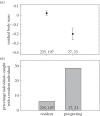The cost of prospecting for dispersal opportunities in a social bird
- PMID: 27330175
- PMCID: PMC4938056
- DOI: 10.1098/rsbl.2016.0316
The cost of prospecting for dispersal opportunities in a social bird
Abstract
Understanding why individuals delay dispersal and become subordinates within a group is central to studying the evolution of sociality. Hypotheses predict that dispersal decisions are influenced by costs of extra-territorial prospecting that are often required to find a breeding vacancy. Little is known about such costs, partly because it is complicated to demonstrate them empirically. For example, prospecting individuals may be of inferior quality already before prospecting and/or have been evicted. Moreover, costs of prospecting are mainly studied in species where prospectors suffer from predation risk, so how costly prospecting is when predators are absent remains unclear. Here, we determine a cost of prospecting for subordinate Seychelles warblers, Acrocephalus sechellensis, in a population where predators are absent and individuals return to their resident territory after prospecting. Prospecting individuals had 5.2% lower body mass than non-prospecting individuals. Our evidence suggests this may be owing to frequent attacks by resident conspecifics, likely leading to reduced food intake by prospectors. These results support the hypothesis that energetic costs associated with dispersal opportunities are one factor influencing dispersal decisions and shaping the evolution of delayed dispersal in social animals.
Keywords: benefits of philopatry; cooperative breeding; delayed dispersal.
© 2016 The Authors.
Figures

Similar articles
-
Delayed dispersal and the costs and benefits of different routes to independent breeding in a cooperatively breeding bird.Evolution. 2016 Nov;70(11):2595-2610. doi: 10.1111/evo.13071. Epub 2016 Oct 6. Evolution. 2016. PMID: 27641712 Free PMC article.
-
Subordinate females in the cooperatively breeding Seychelles warbler obtain direct benefits by joining unrelated groups.J Anim Ecol. 2018 Sep;87(5):1251-1263. doi: 10.1111/1365-2656.12849. Epub 2018 Jun 22. J Anim Ecol. 2018. PMID: 29750837
-
Kinship and familiarity mitigate costs of social conflict between Seychelles warbler neighbors.Proc Natl Acad Sci U S A. 2017 Oct 24;114(43):E9036-E9045. doi: 10.1073/pnas.1704350114. Epub 2017 Oct 9. Proc Natl Acad Sci U S A. 2017. PMID: 29073100 Free PMC article.
-
The evolution of delayed dispersal in cooperative breeders.Q Rev Biol. 1992 Jun;67(2):111-50. doi: 10.1086/417552. Q Rev Biol. 1992. PMID: 1635976 Review.
-
The social structure and strategies of delphinids: predictions based on an ecological framework.Adv Mar Biol. 2007;53:195-294. doi: 10.1016/S0065-2881(07)53003-8. Adv Mar Biol. 2007. PMID: 17936137 Review.
Cited by
-
Evolution of sex differences in cooperation can be explained by trade-offs with dispersal.PLoS Biol. 2024 Oct 24;22(10):e3002859. doi: 10.1371/journal.pbio.3002859. eCollection 2024 Oct. PLoS Biol. 2024. PMID: 39446701 Free PMC article.
-
Fitness consequences of outgroup conflict.Elife. 2022 Jul 14;11:e74550. doi: 10.7554/eLife.74550. Elife. 2022. PMID: 35833830 Free PMC article. Review.
-
Seychelles warblers with silver spoons: Juvenile body mass is a lifelong predictor of annual survival, but not annual reproduction or senescence.Ecol Evol. 2022 Jul 3;12(7):e9049. doi: 10.1002/ece3.9049. eCollection 2022 Jul. Ecol Evol. 2022. PMID: 35813920 Free PMC article.
-
Early-life conditions impact juvenile telomere length, but do not predict later life-history strategies or fitness in a wild vertebrate.Ecol Evol. 2022 Jun 20;12(6):e8971. doi: 10.1002/ece3.8971. eCollection 2022 Jul. Ecol Evol. 2022. PMID: 35784039 Free PMC article.
-
The contribution of extra-pair paternity to the variation in lifetime and age-specific male reproductive success in a socially monogamous species.Evolution. 2022 May;76(5):915-930. doi: 10.1111/evo.14473. Epub 2022 Apr 9. Evolution. 2022. PMID: 35325482 Free PMC article.
References
-
- Emlen ST. 1982. The evolution of helping. I. An ecological constraints model. Am. Nat. 119, 29–39. (10.1086/283888) - DOI
-
- Stacey PB, Ligon JD. 1987. Territory quality and dispersal options in the acorn woodpecker, and a challenge to the habitat-saturation model of cooperative breeding. Am. Nat. 130, 654–676. (10.1086/284737) - DOI
-
- Ridley AR, Raihani NJ, Nelson-Flower MJ. 2008. The cost of being alone: the fate of floaters in a population of cooperatively breeding pied babblers Turdoides bicolor. J. Avian Biol. 39, 389–392. (10.1111/j.0908-8857.2008.04479.x) - DOI
Publication types
MeSH terms
Associated data
LinkOut - more resources
Full Text Sources
Other Literature Sources

